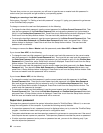
Maintaining the ngerprint reader
The following actions could damage the ngerprint reader or cause it not to work properly:
• Scratching the surface of the reader with a hard, pointed object.
• Scraping the surface of the reader with your ngernail or anything hard.
• Using or touching the reader with a dirty nger.
If you notice any of the following conditions, gently clean the surface of the reader with a dry, soft, lint-free
cloth:
• The surface of the reader is dirty or stained.
• The surface of the reader is wet.
• The reader often fails to enroll or authenticate your ngerprint.
If your nger has any of the following conditions, you might not be able to register or authenticate it:
• Your nger is wrinkled.
• Your nger is rough, dry, or injured.
• Your nger is very dry.
• Your nger is stained with dirt, mud, or oil.
• The surface of your nger is very different from when you enrolled your ngerprint.
• Your nger is wet.
• A nger that has not been enrolled is used.
To improve the situation, try the following:
• Clean or wipe your hands to remove any excess dirt or moisture from the ngers.
• Enroll and use a different nger for authentication.
• If your hands are too dry, apply lotion to them.
Notice on deleting data from your hard disk drive or solid-state drive
As computers spread into every corner of life, they process more and more information. The data on your
computer, some of which might be sensitive, is stored on a hard disk drive or solid-state drive. Before you
dispose of, sell, or hand over your computer, be sure to delete data stored on it.
Handing your computer over to someone else without deleting the loaded software, such as operating
systems and program software, might even violate license agreements. You are advised to check the
terms and conditions of those license agreements.
There are methods that seem to delete the data:
• Move the data to the recycle bin, and then click Empty recycle bin.
• Use the Delete option.
• Format your hard disk drive or solid-state drive, using the software for initializing it.
• Using the recovery program to bring the hard disk drive or solid-state drive back to the factory default
settings.
These operations, however, only change the le allocation of the data; they do not delete the data itself. In
other words, the data retrieval processing is disabled under an operating system such as Windows. The
data is still there, even though it seems to be lost. Thus, it is sometimes possible to read the data by use of
56 User Guide


















